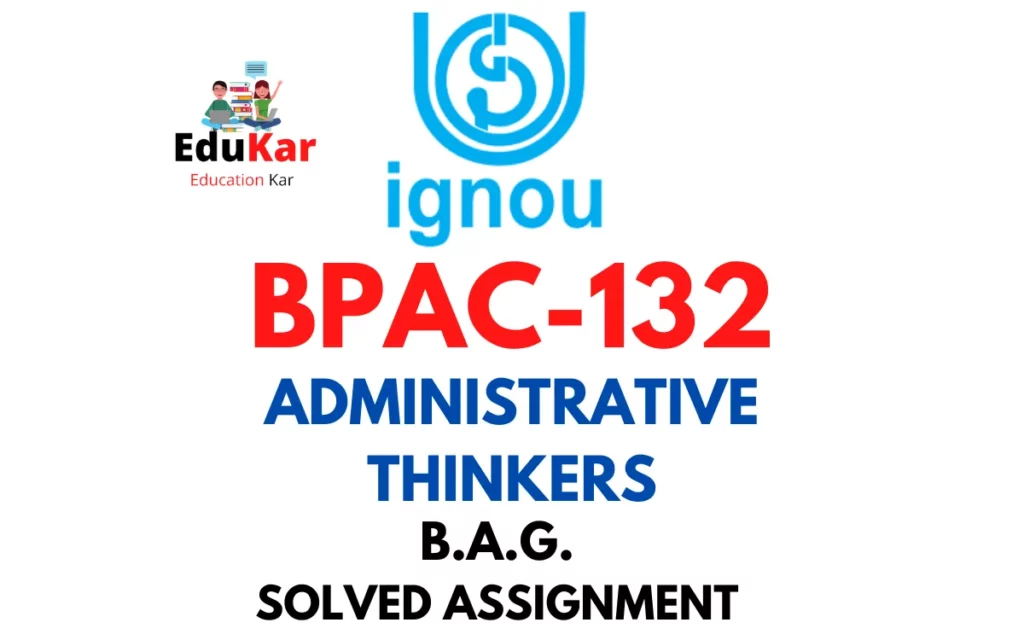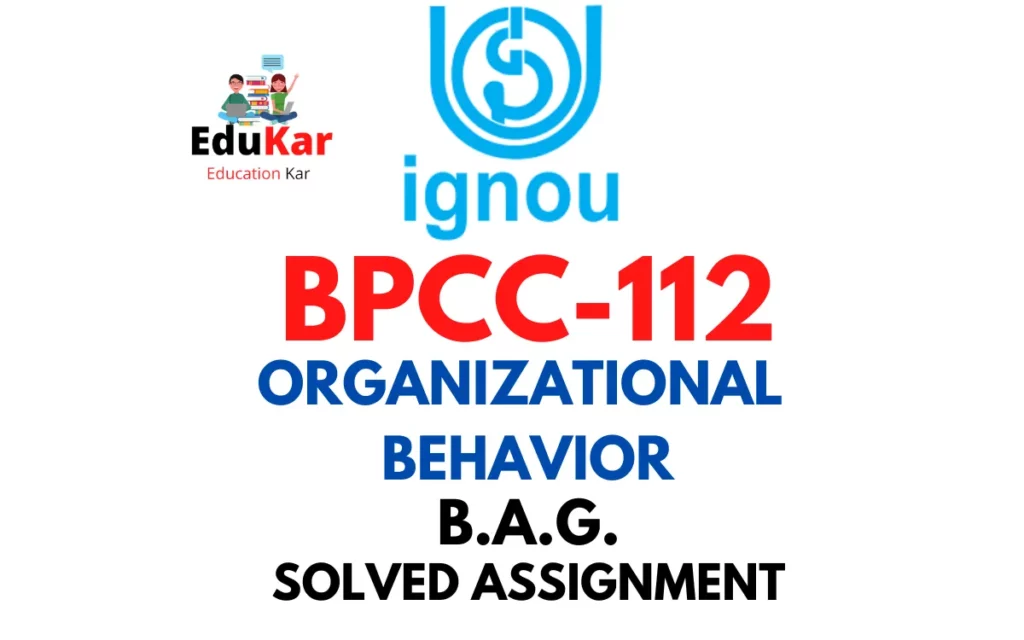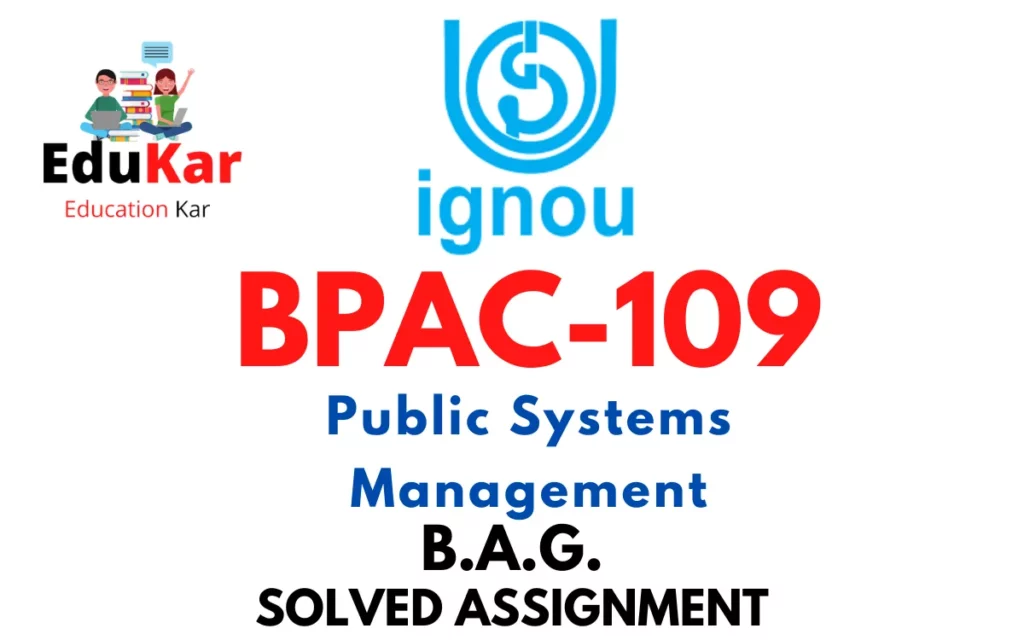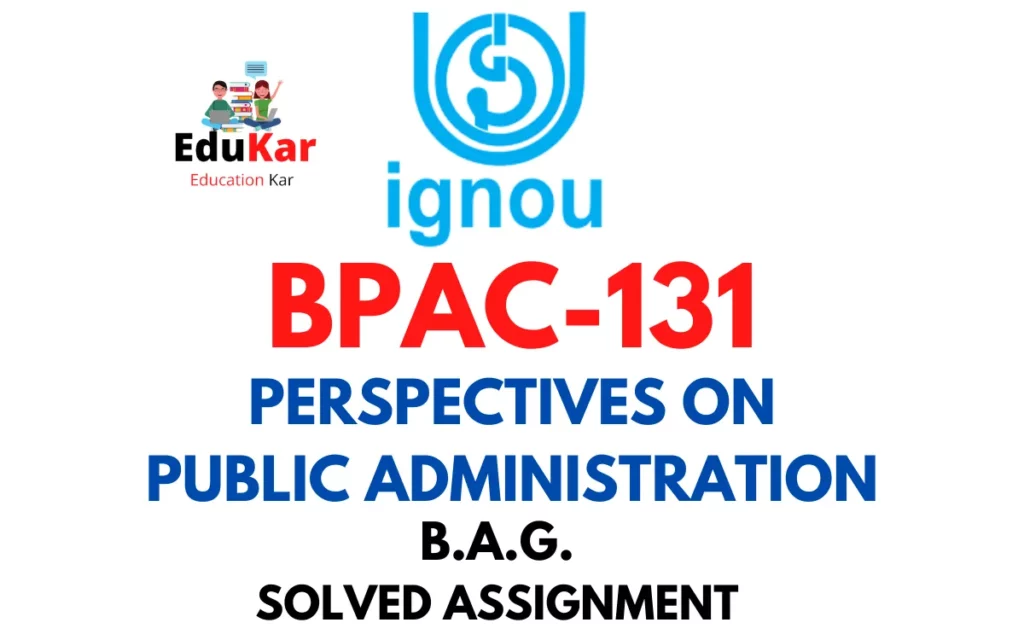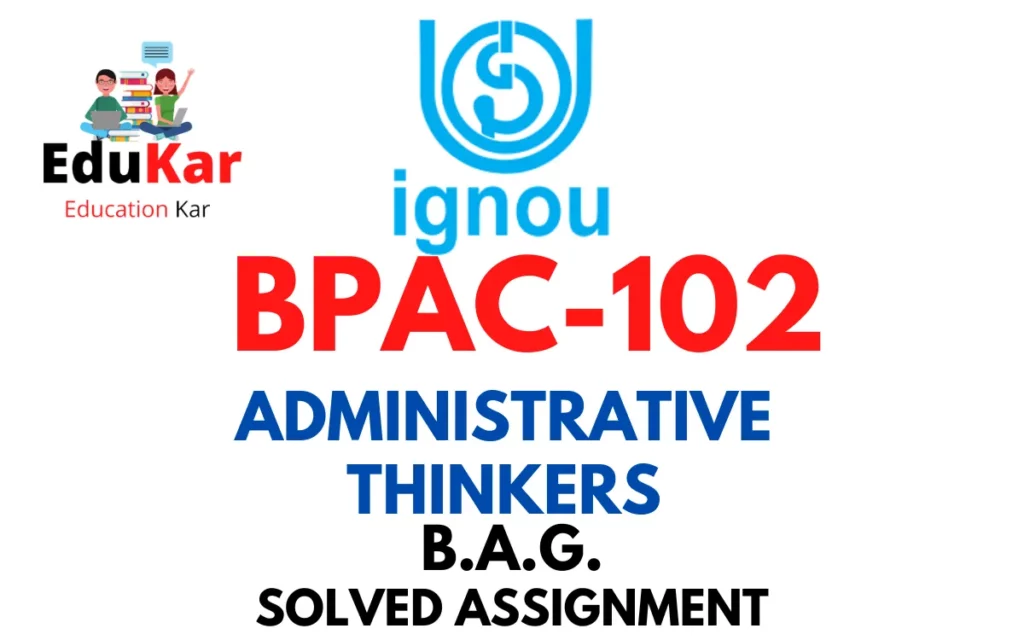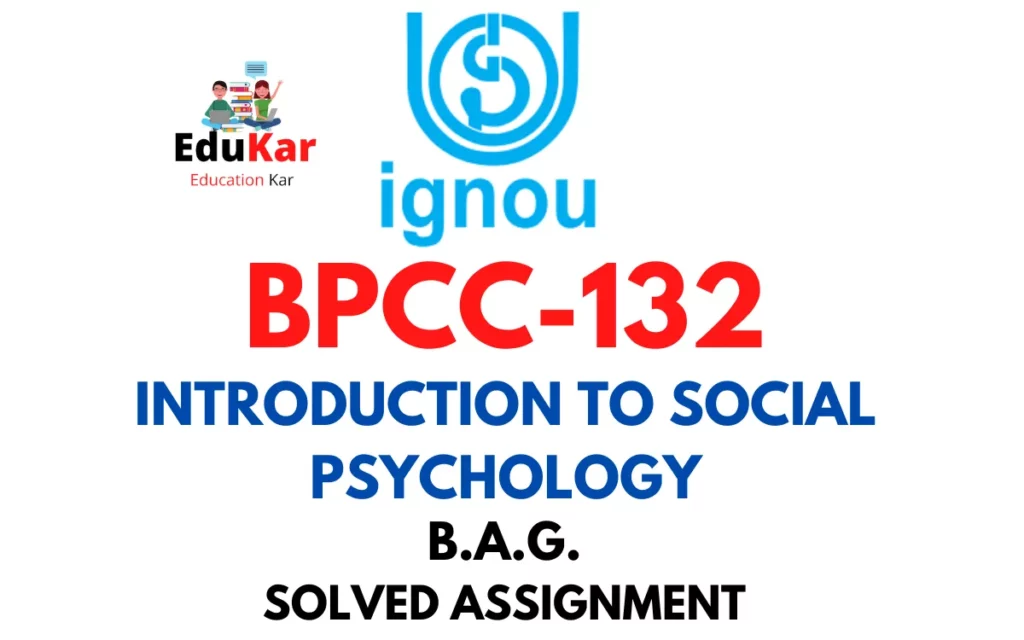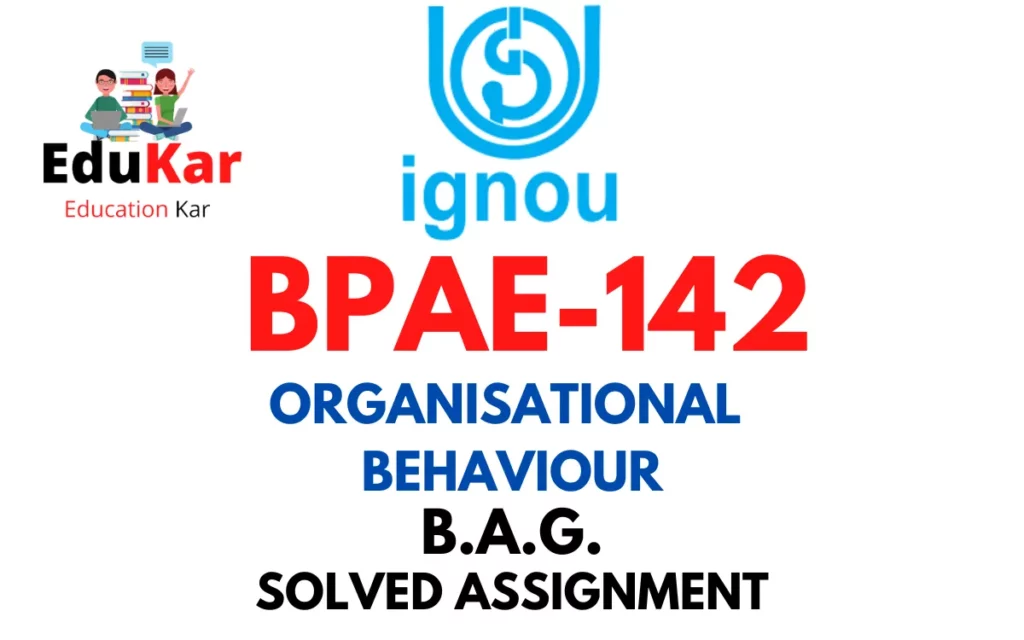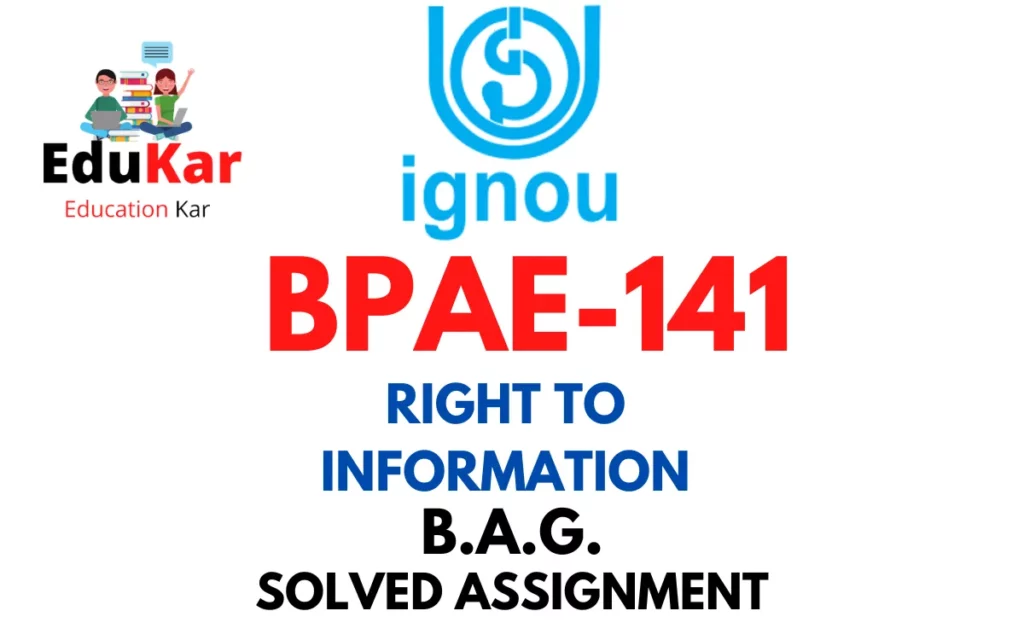Contents
- 1 Assignment A
- 2 Answer the following in about 500 words each.
- 3 1. Discuss the various models of Decision Making.
- 4 2. Discuss the characteristics of Public Choice Approach, as identified by its various proponents of Approach.
- 5 Assignment B
- 6 Answer the following questions in about 250 words each.
- 7 3. Explain the relationship between Public and Private Administration.
- 8 4. Discuss the Hegel’s and Marx’s perspectives on Bureaucracy.
- 9 5. Discuss the concept and features of Governance.
- 10 Assignment C
- 11 Answer the following questions in about 100 words each.
- 12 6. Write a note on significance of Hawthorne studies.
- 13 7. Discuss the concepts of Satisfiers and Dissatisfiers.
- 14 8. Comment on the Rational Policy Making Model?
- 15 9. What are the features of Agrarian and Industria Models?
- 16 10. What do you understand by the Public Interest Approach?
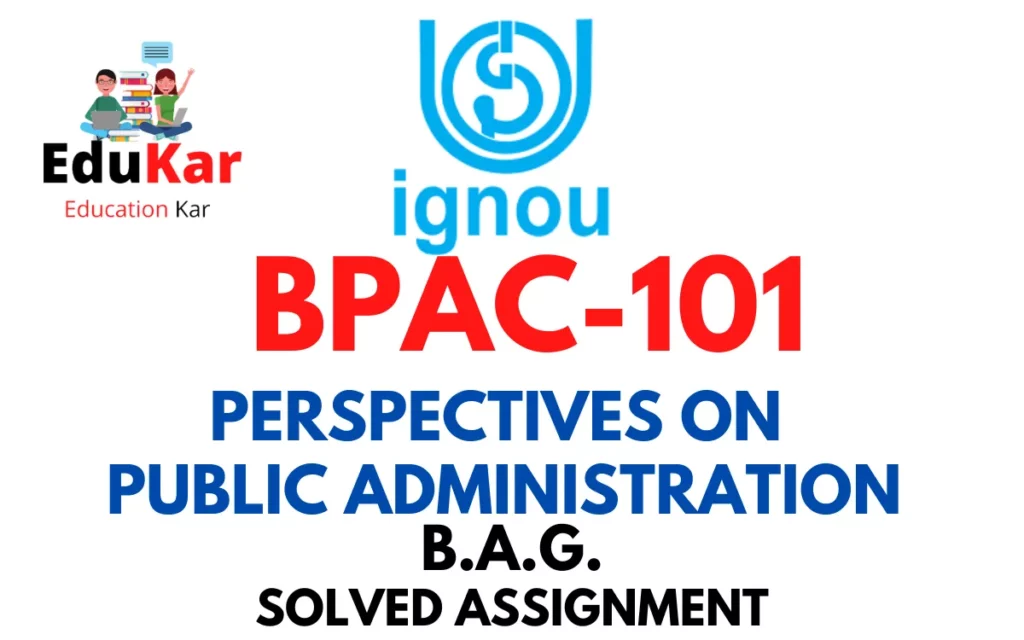
| Title | BPAC-101: IGNOU BAG Solved Assignment 2022-2023 |
| University | IGNOU |
| Degree | Bachelor Degree Programme |
| Course Code | BPAC-101 |
| Course Name | PERSPECTIVES ON PUBLIC ADMINISTRATION |
| Programme Name | Bachelor of Arts (General) |
| Programme Code | BAG |
| Total Marks | 100 |
| Year | 2022-2023 |
| Language | English |
| Assignment Code | ASST /TMA / July 2022 & January 2023 |
| Assignment PDF | Click Here |
| Last Date for Submission of Assignment: | For June Examination: 31st April For December Examination: 30th September |

Assignment A
Answer the following in about 500 words each.
1. Discuss the various models of Decision Making.
Ans: Decision making is the process of making choices among various alternatives. In the field of management and organizational behavior, decision making is a critical component of success. There are several models of decision making that are commonly used in organizations, each with its strengths and weaknesses. In this essay, we will discuss some of the most popular models of decision making.
- Rational Decision Making Model: The rational decision-making model is a systematic, step-by-step approach to decision making that is based on the assumption that decision makers are rational and objective. It involves a seven-step process: (1) identifying the problem, (2) gathering information, (3) identifying alternatives, (4) evaluating alternatives, (5) choosing the best alternative, (6) implementing the decision, and (7) evaluating the results. This model assumes that decision makers have access to all the information needed to make an informed decision and that they will choose the alternative that maximizes their expected utility.
- Bounded Rationality Model: The bounded rationality model is an alternative to the rational decision-making model that recognizes that decision makers are not always rational and that they may not have all the information they need to make a fully informed decision. This model proposes that decision makers satisfice, or choose the first alternative that meets their minimum criteria, rather than optimizing for the best possible outcome. This model takes into account the fact that decision makers have limited time, attention, and resources.
- Intuitive Decision Making Model: The intuitive decision-making model is based on the idea that decision makers often rely on their intuition, or their gut feelings, to make decisions. This model suggests that decision makers may be able to make accurate and effective decisions based on their experience and expertise, even if they cannot explain the reasoning behind their decision. This model is useful when making decisions under conditions of uncertainty or when time is limited.
- Political Decision Making Model: The political decision-making model is based on the idea that decision making is a political process that involves bargaining, coalition building, and negotiation. This model recognizes that decision makers are influenced by a variety of factors, such as personal interests, organizational politics, and power dynamics. This model is useful when making decisions that involve multiple stakeholders with different interests and priorities.
- Garbage Can Model: The garbage can model of decision making is based on the idea that decision making is a messy, chaotic process that involves a variety of inputs, such as problems, solutions, decision makers, and opportunities. This model proposes that decision making is not a linear process, but rather a dynamic, constantly changing one. In this model, decisions are made opportunistically, as problems, solutions, and decision makers come together in a particular way.
2. Discuss the characteristics of Public Choice Approach, as identified by its various proponents of Approach.
Ans: The Public Choice Approach is a framework that seeks to understand the behavior of individuals and groups involved in the political process. This approach is characterized by several key features that have been identified by its various proponents, including:
- Rationality: Public choice theorists assume that individuals and groups act rationally in their own self-interest. This means that people make decisions based on what they believe will benefit them the most, given the information available to them.
- Incentives: Public choice theorists emphasize the role of incentives in shaping behavior. They argue that individuals and groups respond to incentives, which can be positive (rewards) or negative (punishments).
- Political institutions: Public choice theorists view political institutions, such as elections, parties, and bureaucracies, as crucial determinants of political outcomes. They argue that these institutions shape the behavior of politicians, interest groups, and voters.
- Rent-seeking: Public choice theorists are concerned with rent-seeking, which refers to efforts by individuals and groups to use the political process to obtain benefits for themselves at the expense of others. They argue that rent-seeking can lead to inefficiencies and waste.
- Limited government: Public choice theorists generally support limited government, and they are skeptical of the ability of government to solve social and economic problems. They argue that government interventions are often driven by political considerations rather than a genuine desire to promote the public interest.
- Methodological individualism: Public choice theorists emphasize methodological individualism, which means that they focus on the actions of individuals rather than collective entities such as groups or institutions. They argue that it is important to understand the incentives and constraints facing individuals in order to understand the behavior of groups and institutions.
- Positive analysis: Public choice theorists adopt a positive approach to the study of politics, which means that they seek to explain what is happening in the political world, rather than prescribing what should happen. They use empirical methods to test their theories and hypotheses.
Assignment B
Answer the following questions in about 250 words each.
3. Explain the relationship between Public and Private Administration.
Ans: Public and private administration are two distinct fields of management, each with its own characteristics, objectives, and stakeholders. Public administration refers to the management of government organizations, while private administration pertains to the management of business entities. While these two fields may appear to be unrelated, they share some fundamental similarities and differences that affect their relationship.
One key similarity between public and private administration is that they both aim to achieve efficiency, effectiveness, and accountability in the delivery of services. They both require managers to set goals, develop plans, allocate resources, and monitor progress to achieve optimal outcomes. Moreover, both public and private administrators are expected to operate within the legal and ethical boundaries set by their respective sectors.
However, there are significant differences between public and private administration that also affect their relationship. One key difference is the nature of their objectives. While private organizations aim to maximize profits and satisfy the needs of their customers and shareholders, public organizations focus on serving the public interest and meeting the needs of citizens. The scope of decision-making also varies between the two sectors, with private administrators having more autonomy in decision-making compared to public administrators who often have to consider multiple stakeholders and competing interests.
Another significant difference is the level of accountability required in each sector. Public administrators are accountable to elected officials, citizens, and other stakeholders who expect transparency, responsiveness, and integrity in their dealings. Private administrators, on the other hand, are accountable primarily to their shareholders, and their focus is often on delivering profits, which may not always align with the public interest.
4. Discuss the Hegel’s and Marx’s perspectives on Bureaucracy.
Ans: Hegel and Marx, two prominent philosophers of the 19th century, had different perspectives on bureaucracy, although they shared some similar ideas. Hegel, a German idealist philosopher, believed that bureaucracy was an essential aspect of the modern state, while Marx, a German philosopher and economist, viewed bureaucracy as a tool of oppression that perpetuated class inequalities.
For Hegel, bureaucracy was a necessary component of the modern state’s functioning, and he saw it as a way to achieve rational, efficient, and predictable governance. Hegel believed that bureaucracy provided a framework for the state to carry out its functions and responsibilities in an objective and impartial manner. He argued that a bureaucracy could ensure the impartial application of laws, provide a rational basis for decision-making, and establish a clear chain of command that could facilitate the effective implementation of policies. Hegel also believed that a bureaucracy could protect the state from the arbitrary exercise of power and ensure the continuity of governance.
On the other hand, Marx was highly critical of bureaucracy and saw it as a tool of the ruling class to maintain their power and exploit the working class. Marx believed that bureaucracy played a crucial role in perpetuating the capitalist system and maintaining the status quo. According to Marx, the bureaucracy served as a mechanism for enforcing the interests of the ruling class and suppressing dissent and opposition. He saw bureaucracy as an instrument of domination that perpetuated inequalities, perpetuated class differences, and reinforced the power of the ruling class.
Marx was highly critical of the bureaucratic apparatus, which he believed was an integral part of the capitalist system. He argued that bureaucracy served the interests of the ruling class by maintaining the status quo, suppressing opposition, and legitimizing the capitalist system. Marx saw bureaucracy as an instrument of class domination that perpetuated inequalities and reinforced the power of the ruling class.
5. Discuss the concept and features of Governance.
Ans: Governance refers to the processes, structures, and institutions by which public decisions are made, policies implemented, and resources managed in a society. It is a broad concept that encompasses the way power is exercised, the distribution of resources, and the management of public affairs. Good governance is essential for promoting sustainable development, social cohesion, and democracy. The following are some of the key features of governance:
- Accountability: A key feature of good governance is accountability, which requires those in power to be answerable for their actions and decisions. Public officials and institutions must be accountable to citizens, stakeholders, and other actors for their policies and actions.
- Transparency: Transparency is the degree to which information is available, accessible, and understandable to stakeholders. It allows citizens to assess the performance of public institutions and hold them accountable for their actions.
- Participation: Participation refers to the involvement of citizens, civil society organizations, and other stakeholders in decision-making processes. Participation is essential for ensuring that policies are responsive to the needs of citizens and are legitimate.
- Rule of law: The rule of law is the principle that all individuals and institutions are subject to the law, regardless of their status or position. The rule of law is critical for ensuring that policies and decisions are based on legal and ethical principles and are not arbitrary.
- Efficiency and effectiveness: Good governance requires that public institutions and officials are efficient and effective in delivering services and implementing policies. Efficiency and effectiveness are critical for ensuring that public resources are utilized in the most efficient and cost-effective manner.
- Equity and inclusiveness: Governance should be inclusive, ensuring that all groups in society have access to resources and opportunities, and policies should promote equity and social justice.
- Sustainability: Governance should promote sustainable development, ensuring that the use of resources meets the needs of the present without compromising the ability of future generations to meet their needs.
Assignment C
Answer the following questions in about 100 words each.
6. Write a note on significance of Hawthorne studies.
Ans:
The Hawthorne studies were a series of experiments conducted in the 1920s and 1930s to examine the relationship between working conditions and worker productivity. The studies were conducted at the Western Electric Company’s Hawthorne plant in Chicago, and involved a range of interventions, including changes to lighting, rest breaks, and work hours.
The significance of the Hawthorne studies lies in the fact that they were among the first to highlight the importance of human factors in the workplace. The studies showed that factors such as social interaction, group dynamics, and worker attitudes were just as important as physical conditions in determining worker productivity.
The Hawthorne studies also had a profound impact on the field of management and organizational behavior, leading to the development of new approaches to management and the recognition of the importance of employee motivation and engagement. Today, the Hawthorne studies are considered a foundational piece of research in the field of organizational behavior and a critical milestone in the development of modern management theory.
7. Discuss the concepts of Satisfiers and Dissatisfiers.
Ans: The concepts of satisfiers and dissatisfiers were first introduced by psychologist Frederick Herzberg as part of his motivation-hygiene theory of workplace satisfaction. Herzberg argued that there are two types of factors that influence job satisfaction and dissatisfaction: hygiene factors and motivators.
Hygiene factors are those elements of a job that are necessary to prevent dissatisfaction, but that do not necessarily lead to satisfaction. Examples of hygiene factors include adequate pay, comfortable working conditions, and job security. These factors are considered dissatisfiers, as the absence of them can lead to dissatisfaction and low morale, but their presence does not necessarily lead to satisfaction and high motivation.
On the other hand, motivators are factors that contribute to job satisfaction and high motivation, such as opportunities for personal growth, challenging work, recognition, and a sense of achievement. Herzberg argued that these factors are essential to creating a fulfilling and satisfying work experience. These factors are considered satisfiers, as their presence can lead to high levels of motivation and job satisfaction.
According to Herzberg’s theory, increasing hygiene factors alone will not lead to increased job satisfaction and motivation. Instead, managers must focus on providing motivators that will contribute to positive job attitudes and high performance. This means that while it is important to provide adequate pay and working conditions, it is equally important to provide opportunities for personal growth and achievement, as well as recognition for a job well done.
The concepts of satisfiers and dissatisfiers have been influential in the field of organizational behavior, as they provide a framework for understanding the factors that contribute to workplace satisfaction and motivation. By identifying both types of factors, managers can work to create a work environment that not only avoids dissatisfaction, but also promotes positive job attitudes and high levels of motivation.
8. Comment on the Rational Policy Making Model?
Ans: The Rational Policy Making Model is a traditional approach to policy making that assumes that decisions are made in a logical and systematic manner, based on careful analysis of the available information. This model involves a series of steps, including problem identification, goal setting, identification of alternatives, evaluation of alternatives, implementation, and monitoring and feedback.
While the Rational Policy Making Model can be useful in certain circumstances, it has been criticized for a number of reasons. First, it assumes that decision makers have complete information and are able to accurately evaluate all alternatives. In reality, decision makers often face uncertainty and incomplete information, and may have biases that affect their decision-making.
Second, the model assumes that decision makers act in a completely rational manner, considering all possible options and selecting the one that is most likely to achieve the desired outcome. However, decision makers are often influenced by political and personal considerations, and may not act in a purely rational manner.
Finally, the Rational Policy Making Model assumes that the implementation of a policy will be straightforward and predictable, and that it will achieve its intended outcomes. In reality, implementation is often complex and unpredictable, and policies may have unintended consequences or fail to achieve their goals.
Despite these limitations, the Rational Policy Making Model can still be a useful framework for policy makers, particularly in situations where the decision-making environment is stable and the available information is reliable. However, it is important for policy makers to be aware of the model’s limitations and to recognize that decision-making is often a messy, complex process that does not always follow a rational and systematic path.
9. What are the features of Agrarian and Industria Models?
Ans: The agrarian and industrial models are two different economic systems that have different features. The main features of each model are as follows:
Agrarian model:
- Agriculture is the main economic activity, and the economy is based on the production of food and raw materials.
- The population is primarily rural, and social and economic life is organized around agriculture.
- The economic system is subsistence-based, with little surplus production.
- Technology is relatively simple and traditional, and the economy is not highly mechanized.
- Economic relationships are based on personal connections and patronage, rather than formal institutions or markets.
Industrial model:
- Industry is the main economic activity, and the economy is based on the production of manufactured goods.
- The population is primarily urban, and social and economic life is organized around industrial production.
- The economic system is market-based, with the production of surplus goods for sale.
- Technology is advanced and mechanized, and the economy is highly industrialized.
- Economic relationships are based on formal institutions and markets, rather than personal connections and patronage.
10. What do you understand by the Public Interest Approach?
Ans: The public interest approach is a framework used in policy-making and governance that prioritizes the collective good or welfare of the community over individual or private interests. This approach is based on the principle that public policies and decisions should be made in the best interest of the community or society as a whole, rather than for the benefit of particular individuals or groups. The public interest approach recognizes that public resources and institutions should be used for the benefit of all citizens and that policies should promote social justice, equity, and the common good.
How to Download BPAC-101 Solved Assignment?
You can download it from the www.edukar.in, they have a big database for all the IGNOU solved assignments.
Is the BPAC-101 Solved Assignment Free?
Yes this is absolutely free to download the solved assignment from www.edukar.in
What is the last submission date for BPAC-101 Solved Assignment?
For June Examination: 31st April, For December Examination: 30th October

